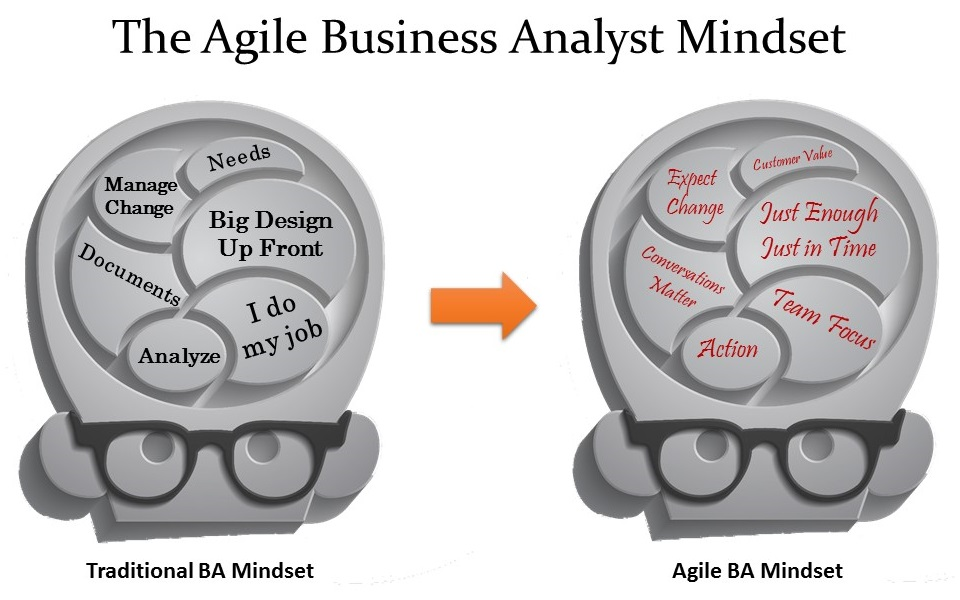In today’s fast-paced business landscape, where adaptability and efficiency reign supreme, the Agile methodology has emerged as a game-changer.
In this context, the role of a Business Analyst (BA) has taken on new significance.
Let’s delve into how Agile business analysts play a pivotal role in ensuring the success of Agile projects, bridging the gap between business objectives and technical implementation.

The Role of Business Analyst in Agile
In the world of Agile, where adaptability and rapid iteration reign supreme, the role of a Business Analyst (BA) takes on a new dimension.
Imagine a bustling construction site – Agile business analysts are the architects who blueprint the project, ensuring that every piece fits together seamlessly. They are the translators between the business realm and the technical domain, weaving a thread of clarity that binds the project’s success.
A Multifaceted Navigator
An Agile BA doesn’t just focus on the what; he is obsessed with the why and how. In the intricate puzzle of an Agile project, they are the keyholders to the realm of business objectives. They diligently gather, analyze, and distill requirements from various stakeholders, transforming abstract aspirations into tangible goals.
Bridging the Gap
While developers and stakeholders speak in distinct languages, an Agile BA is a bilingual navigator. They straddle both worlds, ensuring that the project’s path aligns with the business’s North Star. Their role is to eliminate any ‘lost in translation’ moments, so everyone is on the same page, from the CEO to the coder.
The Agile Orchestra Conductor
Just as an orchestra conductor harmonizes the various instruments to create symphonic magic, Agile business analysts orchestrate teams to work in harmony. They become the glue that holds cross-functional teams together, leading them toward a shared vision. They provide the context that transforms a mere task into a meaningful contribution to the project’s greater purpose.
Fueling Collaboration and Communication
In the Agile methodology, collaboration isn’t just a buzzword; it’s the oxygen that keeps the project alive. Agile business analysts don the hats of facilitators, fostering open communication between stakeholders, developers, and testers. They design and facilitate workshops that bring these diverse groups together, transforming vague ideas into well-defined strategies.
Mastering the Agile Jigsaw Puzzle
Picture Agile as a jigsaw puzzle – each piece representing a user story, requirement, or goal. Agile business analysts are the puzzle masters, ensuring that every piece finds its rightful place. They curate the backlog, ensuring that the most valuable user stories are prioritized, and they help product owners make decisions that align with business objectives.
The Epic Storytellers
Behind every Agile project is a story waiting to unfold. Agile business analysts are the epic storytellers who craft these narratives. They create user stories, the building blocks that developers use to shape their work. These stories breathe life into abstract concepts, making the intangible tangible.
Adapting and Thriving
Agile methodology is a dance of continuous improvement, and an Agile BA is the choreographer. As projects evolve and pivot, they adapt user stories and requirements. They gracefully navigate the twists and turns, ensuring that the project’s path remains aligned with the ever-changing business landscape.
In essence, the role of a Business Analyst in Agile is akin to that of a compass in uncharted waters. They provide direction, clarity, and purpose, steering the project toward its final destination.
As businesses continue to embrace the Agile philosophy, the role of an Agile BA becomes even more vital, ensuring that the journey is as rewarding as the destination itself.
The Agile Business Analyst’s Responsibilities
An agile business analyst is the unsung hero who keeps the wheels turning. Their responsibilities extend far beyond deciphering requirements; they are the glue that binds business objectives with technical execution. Let’s dive into the myriad responsibilities that an Agile BA shoulders to ensure project success.

Requirement Analysis: Decoding the Business Puzzle
At the heart of Agile tasks lies the quest for clarity. An agile business analyst embarks on this journey by meticulously analyzing business requirements. They dissect complex ideas and transform them into bite-sized user stories, ensuring that the development team has a clear roadmap to follow.
User Story Creation: Crafting Narratives for Success
Stories of users are the heartbeat of Agile tasks, and Agile BAs are the master storytellers. They translate business needs into concise and actionable user stories. These stories become the building blocks that guide the development team’s efforts, ensuring alignment with business goals.
Aligning with Business Objectives: Navigating with Purpose
An agile business analyst is like a navigator, steering the ship toward its destination. They work closely with stakeholders to understand the underlying business objectives. Armed with this knowledge, they ensure that every task, every user story, contributes to the overarching vision.
Refining User Stories: Polishing the Rough Diamonds
Stories of users aren’t set in stone; they evolve. An agile business analyst takes on the role of craftsman, refining and polishing user stories based on feedback and changing priorities. They collaborate with stakeholders and the development team to strike a balance between technical feasibility and business value.
Managing the Product Backlog: Curating Value
In the Agile landscape, the product backlog is a treasure trove of potential features. Agile BAs curate this backlog, constantly reassessing priorities and adjusting the order of user stories based on changing business needs. They ensure that the development team always has a clear picture of what comes next.
Embracing Change: Navigating the Winds of Agility
Agile methodology thrives on change, and Agile BAs are its navigators. When requirements shift or new insights emerge, Agile BAs seamlessly adapt user stories and priorities. They ensure that the project remains aligned with business objectives, even as the tides of change continue to flow.
Collaboration Facilitation: Building Bridges
Agile projects are a collective effort, and Agile BAs are the bridge builders. They facilitate collaboration between stakeholders, development teams, and other stakeholders. Through workshops, discussions, and open communication, they ensure that everyone is on the same page.
Managing Changing Requirements: Adapting and Thriving
In the Agile realm, requirements aren’t set in stone; they evolve. An Agile BA thrives in this fluid environment, working closely with stakeholders to manage changing requirements. Their ability to pivot and adapt keeps the project’s course steady, even as the business landscape shifts.
Ensuring Clear Communication: The Voice of Clarity
In the hustle and bustle of an Agile project, miscommunication can be detrimental. Agile BAs serve as the voice of clarity, ensuring that everyone understands the stories of users, requirements, and objectives. Their ability to communicate complex ideas in simple terms fosters effective collaboration.
Balancing Technical and Business Aspects: The Harmonizers
Agile BAs are the conductors of harmony in Agile projects. They ensure that the development team understands not only the technical aspects but also the underlying business context. This balance is crucial for delivering solutions that not only work but also resonate with the business’s goals.
An agile business analyst is a choreographer who ensures that every move aligns with the rhythm of business objectives. Their responsibilities span from requirement analysis to stakeholder collaboration, from user story refinement to managing changing priorities. Agile BAs are the linchpin that holds the project’s pieces together, turning a complex puzzle into a masterpiece of Agile success.
Agile Business Analyst Impact on the Agile Team
In the bustling realm of Agile projects, where cross-functional teams come together to create, innovate, and adapt, Agile BAs emerge as the unsung conductors of the symphony.
Their influence ripples through Agile teams, shaping their dynamics, enhancing their performance, and ensuring that every member is in tune with the project’s goals. Let’s explore how Agile BAs become the driving force behind the success of Agile teams.

Creating a High-Performing Agile Team
An agile business analyst doesn’t just join the team; he elevates it. They infuse teams with purpose, clarity, and direction. Their ability to bridge the gap between business objectives and technical execution turns teams into cohesive units, united by a shared understanding of the project’s mission.
Contextualizing Work: The Why Behind the What
In Agile, tasks aren’t mere checkboxes; they’re purpose-driven endeavors. An agile business analyst provides context, helping dev understand the “why” behind their work. By connecting tasks to business goals, they empower teams to make informed decisions that contribute to the bigger picture.
Facilitating Effective Sprint Planning
Picture a tightly choreographed dance – that’s what sprint planning is for Agile teams. Agile BAs are the choreographers, ensuring that each move aligns with the rhythm of business objectives. They collaborate with dev teams to identify stories of users, prioritize tasks, and allocate resources effectively.
Navigating the Seas of Uncertainty
Agile tasks aren’t immune to changing tides. When new requirements emerge or priorities shift, Agile BAs steer the ship. They adapt the stories of users, reallocate tasks, and keep the team’s compass pointing toward value delivery. Their agility in navigating change fosters resilience within the team.
Aiding Project Management
The Agile business analyst is not just an observer; they’re active participants in project management. They serve as liaisons between stakeholders and dev teams, ensuring that communication flows seamlessly. Their insights enable Project Owners to make informed decisions that drive the project forward.
Fostering Cross-Functional Communication
Agile thrives on collaboration, and an agile business analyst is the glue that binds diverse team members.
They facilitate discussions, workshops, and brainstorming sessions that bridge gaps and break down silos. Their ability to facilitate open communication ensures that everyone’s voice is heard.
Steering Sprint Reviews
Sprint reviews are the culmination of hard work and creativity. An agile business analyst plays a pivotal role by ensuring that the sprint’s achievements align with business objectives. They help translate technical accomplishments into tangible value that resonates with stakeholders.
Aligning with the Agile Mindset
Agile isn’t just a methodology; it’s a mindset. Agile BAs serve as torchbearers of this mindset within Agile teams. They promote collaboration, adaptability, and continuous improvement. By embodying Agile values, they inspire team members to embrace change and strive for excellence.
Bolstering Customer-Centricity
At the core of Agile is the customer’s needs. An agile business analyst reinforces this customer-centric approach by ensuring that every task, every user story, contributes to delivering value to end-users. Their focus on business goals keeps the team’s compass pointed toward customer satisfaction.
Fostering Innovation and Growth
An agile business analyst is not just a project contributor; he is an enabler of innovation. By providing insights into changing business landscapes and market trends, they inspire the team to think beyond the present. Their proactive approach encourages teams to explore new avenues and seize opportunities.
Agile Business Analyst Contribution to Business Value
One of the cornerstones of Agile methodology is delivering business value iteratively. An agile business analyst is instrumental in this process by assisting in feature prioritization based on business value.
They collaborate closely with product owners to shape the product backlog, ensuring that development efforts are aligned with the overall product vision. This focus on value ensures that the delivered software meets the business needs head-on.

Key Skills of an Agile Business Analyst
Success in the Agile environment requires a unique blend of skills. Here we listed some of the essential agile skills that an agile business analyst should have:
Analytical Skills: An agile business analyst is like a detective, piecing together information from stakeholders to uncover the bigger picture. They analyze requirements, stories of users, and data to identify patterns and insights that drive informed decisions.
Communication Skills: An agile business analyst is a translator between technical jargon and business language. They effectively convey complex concepts to both developers and stakeholders, ensuring that everyone is on the same page.
Problem-Solving Abilities: Agile tasks are rife with challenges, and an agile business analyst is a problem solver. They identify roadblocks, explore alternative solutions, and make swift decisions that keep the project moving forward.
Negotiation Skills: An agile business analyst is a diplomat who navigates the delicate balance between stakeholder desires and technical feasibility. They mediate discussions, finding common ground and ensuring that solutions align with both business objectives and development capabilities.
Continuous Learners: An agile business analyst thrives in an environment of learning and growth. They stay updated on industry trends, Agile methodologies, and emerging technologies, ensuring that their skills remain relevant.
Technical and Business Acumen: An agile business analyst speaks two languages fluently: technical and business. Their understanding of both realms enables them to translate business needs into technical requirements and vice versa.
Adaptability: Agile tasks are dynamic, and an agile business analyst thrives in this ever-changing landscape. They quickly adjust to new information, changing priorities, and unexpected challenges, ensuring that the project remains on course.
Time Management: An agile business analyst is a master of juggling tasks and priorities. They ensure that the stories of users are refined, requirements are documented, and stakeholders are engaged, all while keeping the project on track.
Strategic Thinking: An agile business analyst is a chess player, always thinking several moves ahead. They align tasks with long-term business objectives, ensuring that short-term wins contribute to the bigger vision.
Empathy: An agile business analyst puts himself in the shoes of end-users and stakeholders. Their empathy helps them understand needs, pain points, and aspirations, leading to solutions that truly resonate
Agile Business Analysis Artifacts
An agile business analyst relies on various artifacts to facilitate communication and understanding. User stories, acceptance criteria, and business analysis diagrams are some of the tools in their arsenal.
These artifacts not only convey requirements but also help set clear expectations for development teams.
An agile business analyst continually updates and refines these artifacts as projects evolve.

Agile Business Analyst Role in Business Process Improvement
In an Agile environment, software is developed incrementally, with a focus on delivering working software to the customer as quickly as possible but the agile business analyst goes beyond the software development process; they contribute to enhancing business processes.
By collaborating with business stakeholders, they identify inefficiencies and recommend improvements.
Through this collaboration, a business analyst ensures that technology solutions not only address immediate needs but also align with long-term business strategies.
Agile Business Analyst Influence on Agile Mindset
Instilling an Agile mindset across an organization is no small feat. An agile business analyst plays a crucial role by promoting collaboration, adaptability, and continuous improvement. Their emphasis on customer-centricity ensures that the organization remains focused on delivering value to end-users.

Agile Business Analyst Salary
The salary for an Agile Business Analyst can vary widely based on factors such as location, years of experience, industry, and the specific responsibilities of the role.
On average, in the United States, an Agile Business Analyst’s salary can range from around $60,000 to $120,000 or more per year. However, in certain high-demand regions or industries, the salary could be even higher.
Conclusion
Agile Business Analysts are the unsung heroes of Agile project success.
Their ability to bridge the gap between business and technology, coupled with their analytical and interpersonal skills, propels projects toward their goals.
As businesses continue to embrace Agile methodologies, recognizing the pivotal role of Agile BAs and investing in their growth will be key to achieving lasting success.

People Also Ask (FAQs)
How does a Business Analyst contribute to Agile project success?
Agile Business Analysts (BAs) play a pivotal role in ensuring the success of Agile tasks. They bridge the gap between business objectives and technical execution by analyzing requirements, creating user stories, and refining priorities. Their expertise in communication, problem-solving, and stakeholder management fosters collaboration within an agile team, aligning tasks with business goals.
What skills make an Agile Business Analyst valuable to an Agile team?
Essential skills define the Agile Business Analyst’s impact. They possess strong analytical skills to decode complex requirements, effective communication skills to convey insights to both technical and non-technical stakeholders, and strong problem-solving skills to navigate challenges. Their negotiation skills balance stakeholder desires with technical feasibility, and their adaptability enables them to thrive in Agile’s dynamic environment.
How do Agile Business Analysts foster collaboration within an Agile team?
Agile Business Analysts are the bridge builders who facilitate communication and collaboration within an Agile team. They leverage their communication skills to convey requirements and insights clearly, ensuring that developers and stakeholders share a common understanding. Their role in sprint planning and facilitating workshops ensures that all team members actively contribute, fostering a sense of ownership and shared purpose.



